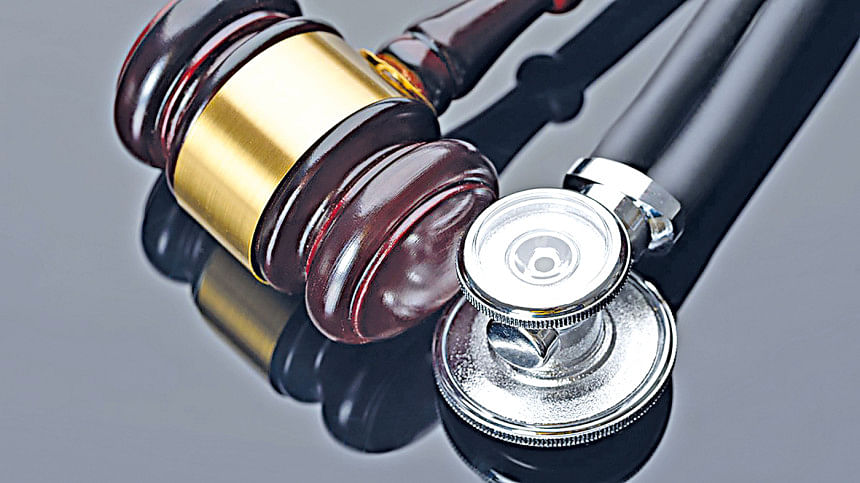Need for a Doctors’ Protection Act?

In Bangladesh violence against doctors has become quite a common phenomenon. The violent confrontations between doctors and patients or their attendants often stem from delays in treatment, adverse outcomes, or sheer frustration with an overstretched healthcare system. However, behind most incidents lie a deeper reality: public expectations collide with systemic failures, and doctors, stranded between institutional neglect and human despair, become the easy targets. While medical negligence is a reality, but violence can never be a solution to that. We need frameworks to manage grievances on both sides. Indeed, while we need laws to deal with medical negligence, we also need laws to protect the doctors from violence and threats of violence.
The public often sees doctors as authoritative, privileged, and well-positioned. Yet beneath that perception often lies a very different reality. Overburdened government hospitals, under-equipped facilities, and a critical lack of staff define the everyday realities for the public sector physicians in Bangladesh. A government doctor may face three times the recommended patient load and still be expected to deliver care that meets adequate standards. When outcomes disappoint, as they often will under such strained conditions, the blame falls solely on the doctors.
This blame often transforms into hostility. Verbal abuse has already become commonplace, and physical intimidation is no longer rare either. The culture that permits such acts sees violence not as a breakdown of civil norms but as an understandable outburst— one that medical professionals must tolerate as part of their noble profession and moral bindings. And yet, when these incidents occur, police are hesitant to intervene, hospital authorities look to avoid "unnecessary escalation," and doctors are advised to "let it go." The outcome is impunity and frustration, leading to systemic failure.
The legal architecture, meanwhile, remains indifferent. The Penal Code 1860 criminalises assault on public servants (section 353). However, this provision is unevenly applied to doctors, particularly those in private or semi-government institutions. Even where it does apply, enforcement is sporadic, and few cases proceed to court. In the absence of a targeted legal mechanism, doctors remain legally vulnerable— and are often left practically unsupported.
The Penal Code's general provisions were never tailored to the unique pressures and vulnerabilities of the medical service. Without a targeted statute, enforcement agencies lack clarity, institutions lack obligations, and victims lack avenues for swift recourse. This inadequacy does not merely leave doctors unprotected; it normalises their exposure to risk as an inevitable cost of their profession and also affects the structural fiduciary relationship that should exist between the patients and the physicians.
In light of the above, a new law can be helpful. But what should it look like? At its core, a Doctors' Protection Act should explicitly recognise all registered healthcare professionals—public and private—as protected under the law while on duty. It should criminalise threats, abuse, and physical harm with graded penalties. It should also mandate institutional safeguards and rapid police responses and provide for fast-track adjudication where necessary.
Some of Bangladesh's regional neighbours have already moved toward such reforms. In parts of India, attacks on doctors are treated as non-bailable offenses under states legislation. In Pakistan, provinces such as Sindh have introduced healthcare protection bills, and Sri Lanka has adopted administrative protocols and hospital-based security frameworks to reduce the risk of violence. Beyond South Asia, several countries have taken bolder legislative steps. In Australia, for instance, many states have made assaulting healthcare workers an aggravated offense with enhanced penalties. In the United Kingdom, under the Assaults on Emergency Workers (Offences) Act 2018, violence against healthcare staff triggers stricter sentencing. In the United States, numerous states classify attacks on healthcare providers as felonies, recognising their vital societal roles.
Legal reform, of course, is not a panacea. But it is an essential starting point. It can bridge the difference between expecting protection and actually receiving it. A well-drafted, narrowly tailored law can serve both symbolic and practical purposes. It can deter future violence through clear consequences and empower doctors to assert their rights without fear of reprisals.
The writer is Lecturer in Law, Sonargaon University (SU), Dhaka and Advocate, District and Sessions Judge Court, Dhaka.

 For all latest news, follow The Daily Star's Google News channel.
For all latest news, follow The Daily Star's Google News channel. 



Comments